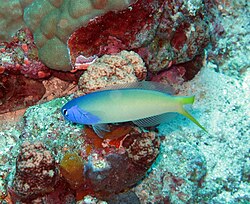| Hoplolatilus Temporal range: | |
|---|---|
 | |
| Bluehead tilefish (Hoplolatilus starcki) | |
| Scientific classification | |
| Kingdom: | Animalia |
| Phylum: | Chordata |
| Class: | Actinopterygii |
| Order: | Acanthuriformes |
| Family: | Malacanthidae |
| Subfamily: | Malacanthinae |
| Genus: | Hoplolatilus Günther, 1887 |
| Type species | |
| Latilus fronticinctus Günther, 1887 | |
| Synonyms | |
| |
Hoplolatilus is a genus of tilefishes native to the Indian Ocean and the western Pacific Ocean. The chameleon tilefish (Hoplolatilus chlupatyi), also known as the flashing tilefish, is well known in particular in the aquarium hobby due to its unique ability to change colors in an instant with the help of specialized proteins in its skin that can reflect light in different wavelengths, allowing it to cycle between primary and secondary colors on the light spectrum. [1]